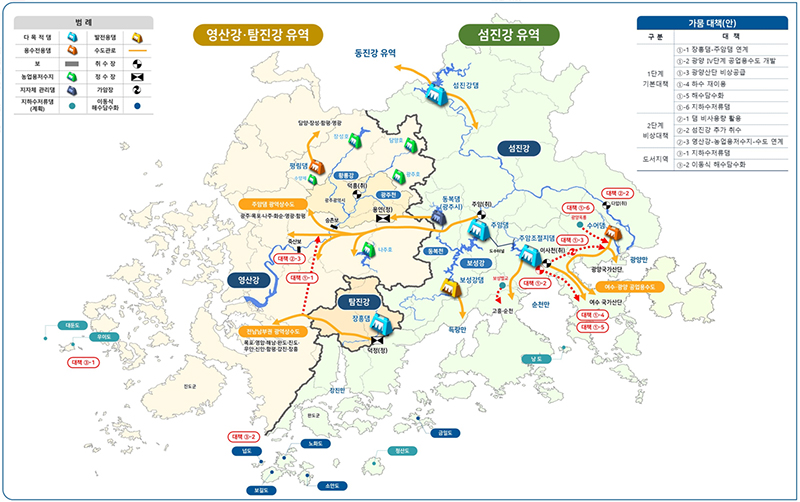Ministry of Environment announces ‘Major Directions for Mid- to Long-term Drought Measures in Gwangju and Jeonnam Region’
As the drought continues in Gwangju and Jeonnam, the Ministry of Environment is promoting mid- to long-term drought measures, such as installing water pipes between dams.
The Ministry of Environment announced the ‘Major Directions for Mid- to Long-term Drought Measures in the Gwangju and Jeonnam Region’ at the Sejong Government Complex on the 3rd, and plans to finalize the mid- to long-term drought measures within this month after consultations with related organizations and deliberation and resolution by the National Water Management Committee. said.
The Ministry of Environment plans to prepare mid- to long-term drought measures first, starting with Gwangju and Jeonnam, where severe droughts have continued since last year.
An official from the Ministry of Environment explained, “We calculated the water shortage for living and industrial use based on the re-evaluation result of dividing the water demand forecast and the water supply capacity of major dams into the maximum drought and the extreme drought considering the impact of climate change.”
Accordingly, the drought response consisted of the first phase basic measures and the second phase emergency measures. For the Jeonnam island (island) region, a separate customized measure is established to suit the conditions and characteristics.
‘Phase 1 Basic Measures’ assumes that the biggest drought that has occurred in the past will occur simultaneously for each dam (Juam Dam, Sueo Dam, Seomjingang Dam, Pyeongnim Dam, Jangheung Dam, Dongbok Dam) in the Yeongsan River and Seomjin River basin, so that living and industrial water is stable. The goal is to secure an additional 450,000 tons of water per day to be supplied.
The ‘Second Phase Emergency Response’ assumes that climate change will cause an extreme drought that exceeds the previous maximum drought, and aims to additionally secure more than 160,000 tons of water per day in addition to the first phase so that there is no disruption to the minimum daily and industrial water supply. all.
In the first stage, a plan to prepare a water supply line so that Jangheung Dam can supply (100,000 tons per day) instead of water (480,000 tons per day) supplied by Juam Dam to six local governments, including Gwangju and Jeonnam Mokpo, Naju, Hwasun, Hampyeong, and Yeonggwang. contains
The basic plan also included a plan to establish a new water supply line so that the surplus water generated by the Juam Dam can be supplied to the Yeosu Industrial Complex by operating the Juam Dam and the Jangheung Dam in connection. To this end, an additional 45.7km water supply pipe will be installed from the Isacheon water intake to the Yeosu Industrial Complex.
In addition, to secure additional water supply sources in Goheung, Gwangyang, Boseong, and Suncheon in South Jeolla Province, the plan is to review the development of two underground water storage dams and build seawater desalination facilities to supply industrial water to the Yeosu Industrial Complex.
The water pipe network replacement/improvement project to prevent 42 million tons of tap water leaks by 2035 will also continue to be promoted.
As a second-stage emergency measure, use the ’emergency capacity (capacity between the low water level and the emergency outlet)’ and ‘used water capacity (capacity between the bottom of the dam and the emergency outlet)’ at the water level below the reservoir level of the dam to supply living and industrial water. A supply plan has been proposed.
It was also decided to review a plan to additionally collect water from the Seomjin River and supply it to the Yeosu and Gwangyang industrial complexes.
In island areas that are constantly experiencing difficulties in securing water, plans are being promoted to expand the installation of groundwater storage dams to prevent seawater infiltration and secure water for living.
Container-type mobile seawater desalination facilities will be used to supply water to areas such as Neopdo, Wando-gun, where emergency water supply is difficult due to the difficulty of seawater desalination vessels berthing.
In addition, the Ministry of Environment is promoting a plan to operate the 16 weirs of the main streams of the four major rivers (Han, Nakdong, Geum, and Yeongsan) as water bowls to the fullest to help with drought.
Due to the rise in the water level of the weir, the water depth of the main stream and tributaries is secured above a certain level to supply drought response water, and through this, stable water for living, industry and agriculture is supplied to 70 water intake and pumping stations and 71 groundwater use areas located in the weir affected section of the four major rivers. An official from the Ministry of Environment explained that it plans to supply it to .
Minister of Environment Han Hwa-jin said, “The key to this mid- to long-term drought response is to stably supply water for living and industrial use so that even if a severe drought occurs again in the Gwangju and Jeonnam regions, there will be no disruption to the lives of residents and the national economy.” Regarding the watershed, we will thoroughly prepare for the climate crisis by preparing mid- to long-term measures to ensure a stable water supply even in extreme droughts by the end of this year.”

Source: Policy news, korea.net link


Comments
It’s very informative.